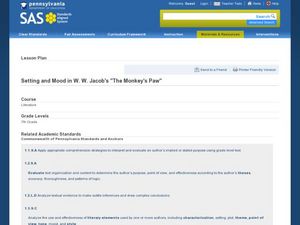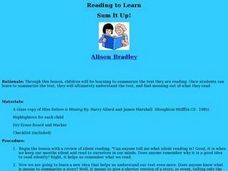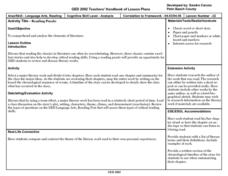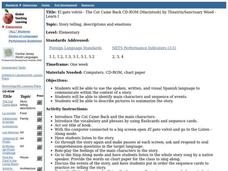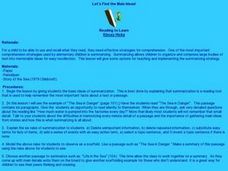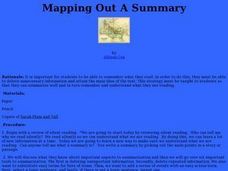Curated OER
Middle East Related
Eighth graders find a current event related to the Middle East. In this current event lesson students write a brief summary of a new story related to the Middle East. They give their opinion and tell how it affects their life or who it...
Curated OER
Making Inferences
Students discover how making inferences helps people solve problems. In this inference lesson, students read a story aloud and discuss problems as they occur in the story. Students work in small groups and use events in the text to infer...
Curated OER
The Importance Setting and Mood in Fiction
Seventh graders examine the setting in pieces of fiction. In this story analysis lesson, 7th graders investigate the setting in fictional stories and the importance it has. Students discover new vocabulary terms applying to...
Reed Novel Studies
Beezus and Ramona Novel Study
What are some of the advantages and disadvantages of having siblings? Pupils explore this topic with the Beezus and Ramona novel study. Additionally, scholars answer questions about chapter one of the time-honored book by Beverly Cleary...
Curated OER
Summarize What You Read
Third graders summarize a selected piece of nonfiction text. After reviewing the correct way to use a Venn diagram, 3rd graders read a nonfiction article. They write a summary paragraph using their Venn Diagram and the five-step process...
Curated OER
Maus: Making a Visual Representation
How do you represent a tragic event? Are stories of tragic events better left untold? After reading chapter two of Maus and studying other representations of the Holocaust (suggestions are included), class members create a representation...
Curriculum Corner
Summary Writing
Nineteen stylish worksheets offer lesson ideas and practice opportunities designed to reinforce summary skills. Scholars recall events over the weekend as well as favorite books—main characters, problems, solutions, the beginning,...
Curated OER
Introducing Literary Elements in Fiction
Identify literary elements in fiction. In this reading comprehension lesson, learners read the book Pigsty and record literary elements onto a graphic organizer. They specifically discuss the main characters and events in the text.
Curated OER
The Legend of the Indian Paintbrush
Third graders complete activities for the book The Legend of the Indian Paintbrush, by Tomie dePaola. In this literature lesson, the students read the story and summarize the main events. They look for story elements focusing on the...
Curated OER
Reading to Learn: Sum it Up!
Students practice summarizing texts they are reading to aid in their understanding of what they have read. After learning the steps involved in summarizing a text, students practice the five basic steps used in summarization.
Curated OER
Babushka's Doll
Third graders read the story Babushka's Doll and write a summary of the main events in the story. In this summaries lesson plan, 3rd graders discuss the country of Russia before they read.
Curated OER
Short and Sweet
Students summarize nonfiction text. After reviewing the process for reading in order to summarize, students independently read a nonfiction article. They write a summary paragraph using the checklist outlined by the instructor during...
Curated OER
Map Out the Important Stuff!
Students practice summarization by creating a story map. Students listen to a read aloud by the teacher, after which the class creates a storymap of the major events in the story. They read a passage from the Indian in the Cupboard...
Curated OER
Sheila Rae the Brave
First graders practice summarizing with the book Sheila Rae the Brave by Kevin Henkes. In this summarizing instructional activity, 1st graders read the story over 3 days and answer comprehension questions. They write a summary about what...
Curated OER
Reading Puzzle
Twelfth graders examine the elements of literature. They each read a chapter of a novel, sequentially list the main ideas, present a summary of the chapter to the class, sequence the events, and review the novel by summarizing the timeline.
Curated OER
The Cat Came Back
Students are read the story "The Cat Came Back". Using Spanish, they communicate the context of the story with each other. They practice using new vocabulary, identifying main characters and putting the events into order. They use the...
Curated OER
Map the Mystery!
Seventh graders read the novel, "The House of Dies Drear", and create a story map to analyze the plot and recall events.
Curated OER
Let's Find the Main Ideas!
Third graders examine how finding the main ideas and summarizing increases their reading comprehension. They read "The Sea in Danger" while applying the six rules of summarization in a modeled lesson. Next, working in small groups, they...
Curated OER
1, 2, 3...A Summary
Students summarize a piece of nonfiction text. After reviewing the correct way to gather the important information needed to summarize, students independently read a nonfiction article. They write a summary paragraph using the process...
Curated OER
Mapping Out A Summary
Learners summarize a selected piece of fiction text. After reviewing the correct way to read silently, students read a chapter in the novel they are currently reading. They write a chapter summary using a story map and the process...
Curated OER
The Secret School-Chapter 4
Fourth graders read The Secret School. In this language arts lesson, 4th graders discuss the characters in the story and read aloud using fluency while reading. Students write a summary of the chapter.
Curated OER
Global Issues
High schoolers explore the ways that local, national, and global events are interconnected. They identify current issues at a local and global level, identify organizations that seek to improve conditions in other countries, and examine...
Curated OER
Introducing Literacy Elements in Nonfiction
Explore nonfiction writing with your class. They will identify elements in nonfiction by reviewing elements of fiction. Then they use biographies, memoirs, menus, Time for Kids, and text books to identify elements of nonfiction. They...
Curated OER
Tales of Edgar Allen Poe
Analyze the writing of Edgar Allen Poe by reading and then writing in a similar style. Budding authors learn about the life of Poe and read one or more of his famous works online. Partner groups create an original piece of writing using...




